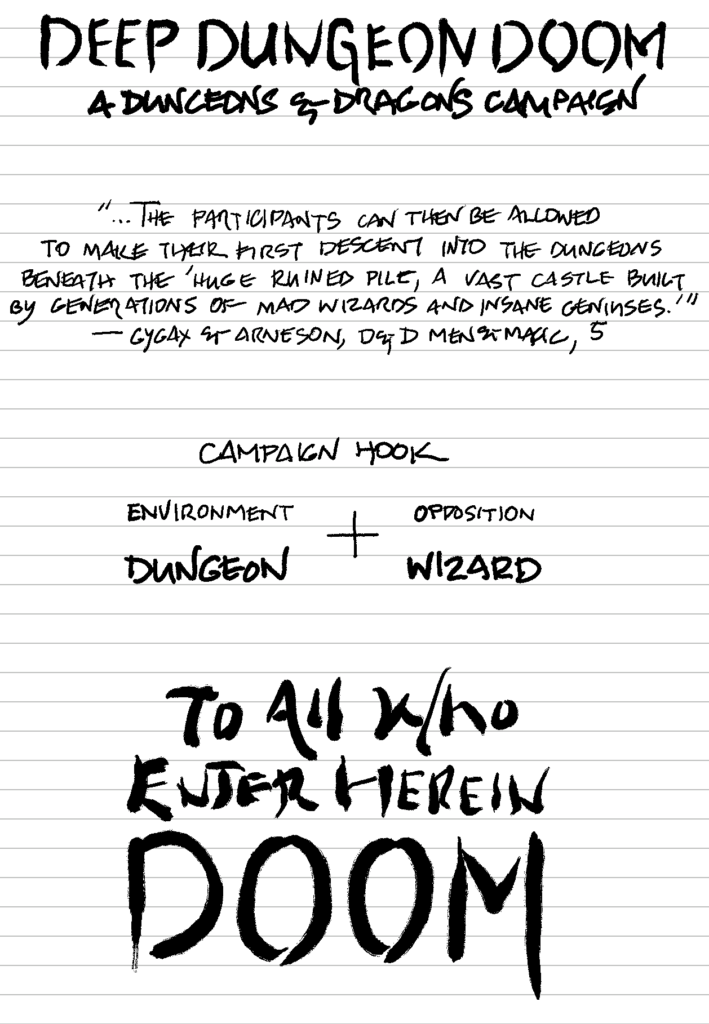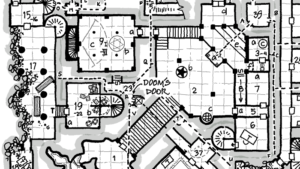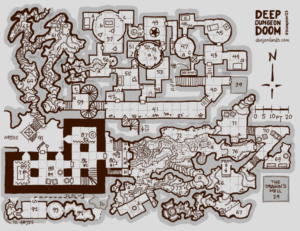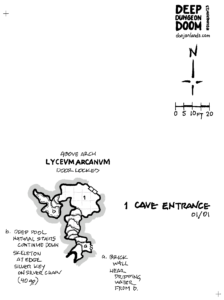In Deep Dungeon Doom, I follow #Gygax75 and #Dungeon23 to create a D&D dungeon campaign in a few minutes per day for one year. I intend to post irregular updates here. To get the daily rooms, follow me on Mastodon and Twitter.
Gary Gygax, in the Europa article (April 1975), notes mythology, folklore, and fantasy and swords & sorcery literature as typical sources of inspiration.
“Settings based upon the[se] limits (if one can speak of fantasy limits) can be very interesting in themselves, providing the scope of the setting will allow the players relative free-reign to their imaginations” (18).
In addition to listing our inspirational sources, Ray Otus suggests we write a few concise bullet points in describing the campaign setting to arouse the players’ excitement (The Gygax 75 Challenge, 7). My general inspiration, as well as two of five specific sources, comes rather more from D&D itself. The dragon eats its tail.
Mimicking a source, I preface the lot with a brief background. And, because Winninger’s Dungeoncraft is in my DNA, I make up a secret, which I hide behind a spoiler tag. Those who wish to explore the dungeon in play should not peek.
Background
“…the dungeons beneath the ‘huge ruined pile, a vast castle built by generations of mad wizards and insane geniuses.’”
—Gygax and Arneson, Men & Magic (D&D Vol. 1, 5)
The last of these mad wizards desired godhood. In a laboratory on the dungeon’s lowest level, Daerdread Fearthoht constructed a device that would channel divine energy. She had only to capture a god. A religious order tricked the wizard, trapping her in the device, thus preventing the apotheosis and rendering the wizard impotent. But not before Fearthoht, now called Doommaker, threw a powerful curse on the dungeon: “To all who enter herein—DOOM!”
Doommaker
Fearthoht feigns impotence. Though trapped in Godthrone, she communes with a sect of evil mage-priests devoted to the would-be deity. The mage-priests have reversed the energy flow between trap and device. Their continuous prayers restore the wizard’s power.
Description
- DONJON LANDS setting: The campaign takes place in a far-future Earth: “a world with magic, monsters, and a ring around it, with stars that aren’t fixed but dance and swirl.” See also its creation myth Song of the World Dragon.
- Medieval Greek and Roman culture: An empire recently encompassed the known world. Following a collapse of imperial power in the west, an overlord retains power over eastern realms.
- Dungeon campaign: Game play focuses on dungeon exploration with occasional wilderness forays.
- Wizard opposition: The principal villains are Fearthoht Doommaker and an array of powerful wizards and their many and diverse minions.
- Fun-house dungeon: Encounters and adventures are intended to be fun without so much attention to fantastic realism.
- Deadly: The mood is doom.
fun house noun
: a building in an amusement park that contains various devices designed to startle or amuse

Inspiration
- Tegel Manor: Commonly considered the original fun-house dungeon, the 1977 Judges Guild module’s terse descriptions also lend well to #Dungeon23’s short-handed stocking method.1
- Magic-users of Jack Vance and Clark Ashton Smith: Various works of these two authors portray the sort of “mad wizards and insane geniuses” I’m looking for.
- How to Host a Dungeon: Not playing through it, I use the rules booklet as a reference work. Tony Dowler’s dungeon-building game provides primordial nexuses, ancient civilizations, and master villains to fill out the dungeon’s space and history should need arise. I may elaborate on this point later.
- World history: The campaign is set in a place and time similar to the 11th-century Byzantine Empire.
- Greek and Roman mythologies: Gods and religion are drawn from an amalgam of these two real-world mythologies.
My notebook is a reMarkable tablet.
1 “365 rooms written like ‘3 orcs, 25 gold pieces’ is better than 5 rooms written like ‘In this beautiful hand carved obsidian room sit 3 orcs arguing over a dice game. 25gp sit on the table, each of them…’ See what I’m getting at?”—Sean McCoy, “#Dungeon23”



Pingback: Using How to Host a Dungeon for #Dungeon23 – DONJON LANDS